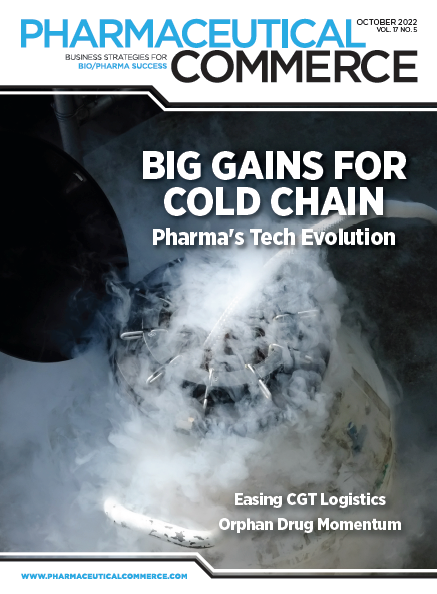Choosing the Right Monitoring Device
Selecting the appropriate type of temperature-monitoring device starts with understanding the capabilities needed for a specific product
In the wake of the COVID-19 pandemic, the supply chain industry experienced a renewed sense of why maintaining a safe, unbroken, and properly functioning delivery system is important, especially for pharmaceutical products. Within this, the cold chain has two main responsibilities: keeping temperature-sensitive products within their required temperature range and facilitating the product transfer from touchpoint to touchpoint.
The cold chain must maintain integrity, visibility, and accountability every step of the way to satisfy increasing demands from a variety of stakeholders. Medicines, test kits, and vaccines have always used the cold chain, but the temperatures and conditions seen at the forefront of the COVID vaccination efforts exemplified why maintaining a steady cold chain is so crucial. Even now, with infection rates surging around the world, many are seeking the vaccine, as well as the booster shot to add an extra layer of protection, with the understanding that it will be as effective as possible.
Because of this increased need, those who rely on the cold chain to keep products within a certain threshold are now dealing with the daily struggle of new guidelines and regulations, as well as the growing room for error that comes with the handling and distribution of large quantities of temperature-sensitive products. The expedited transfer of vaccines and medical products in general can affect the cold chain negatively, especially when products do not arrive at their destination in the expected condition.
With all of the opportunities for deviation throughout the supply chain process, temperature-monitoring devices are essential in ensuring the most effective delivery from beginning to end. Potential errors, including broken storage containers and freezers, spilled product, and even product spoilage when exposed to improper temperatures or impacts, make the shipping and delivery process high stakes for both shippers and consumers, but these issues can be monitored and prevented with the right technology.
Cold chain products
Within the pharma industry, products are categorized based on a wide range of variables such as type, use, and even temperature threshold. Some products, like a few of the COVID vaccines, require ultra-cold temperatures to maintain efficacy, ranging from -130 to -76°F. Some products, such as insulin, might not require a below-zero environment, and can have a larger temperature threshold, but still require some form of refrigeration to maintain the typical range of 36 to 46°F. Even still, other products can be maintained at a controlled room temperature (CRT), usually between 60 to 77°F.
Angela Kerr

Regardless of its temperature threshold, a pharma product should always be kept within the outlined range—from the beginning of the supply chain all the way through the last mile—to ensure efficacy. Unfortunately, this doesn’t always happen. Freezers break, unexpected delays occur, warehouses are warmer than expected, and prescriptions are left sitting on doorsteps for hours before the recipient retrieves the package. There are numerous things that could happen at any point within the cold chain to push a product out of its desired temperature range. Thankfully, there are several devices that companies can incorporate to monitor and track the temperatures of their products throughout the entire length of the supply chain.
Temperature-monitoring devices
Before implementing a temperature-monitoring device, it’s important to first identify the point within the supply chain where it’s needed, how detailed the monitoring should be, and what the desired temperature range is. These key points will then inform the type of device that would be best suited for the given product. There are several options to pick from when optimizing the cold chain, including temperature indicators, recorders, and labels. For example, a manufacturer looking for a device with a visual indication might be best suited to implement a single-use, color-changing indicator. Another manufacturer looking to track and have recorded proof of temperature excursions might be better off using a temperature recorder that either provides downloadable information via USB or utilizes a wireless network to transfer the measurements as soon as the product in question is exposed to an out-of-tolerance temperature.
Indicators are both easy to use and easy to implement. Typically, single-use can be applied to individual products or entire packages within a shipment. Several indicators leverage color-changing technology, allowing them to deliver clear evidence of unacceptable temperature exposure and even the length of time of the temperature excursion. Available in multiple ranges, these time-temperature devices change color to indicate temperature changes and the length of time that those changes were maintained. This data allows handlers the ability to make quick decisions, such as if a product needs to be thrown out or used first in inventory rotations. Its irreversible nature also makes it impossible for mishandling to go unnoticed. For example, if a shipment was left out in the sun too long, then put back into a freezer, the affixed indicator would still show that a deviation had occurred.
These devices can also be field-armable, meaning they can be activated right before use. If a supply chain anticipated deviations at one specific checkpoint, an indicator could be applied and activated before transporting the shipment through that specific stage of the supply chain, to make sure deviations are avoided, if possible, but caught if they occur.
Similarly, recorders can be helpful for products with stringent handling and temperature requirements. Like indicators, recorders provide handlers with the knowledge necessary to decide if a shipment or product is safe to use. It also provides incontrovertible proof of the temperatures reached during transit, whether within the set threshold or not. Lastly, it allows manufacturers, shippers, and other parties within the supply chain to correlate deviations with specific locations. For example, continuous use of a recorder might reveal temperature deviations at one specific warehouse for every shipment. That key information then enables companies to make decisions best suited for their business and optimization needs. Unlike color-changing indicators, recorders are more in-depth, recording the entire length of the supply chain, and then providing downloadable data via USB when the transfer is completed.
Regardless of the device used, having something to monitor and track the temperature of products through the supply can greatly reduce the chance of temperature excursions. When handlers understand that a monitoring program is in place, they are more likely to take greater responsibility with the shipment.
Valuable path
As these devices continue to evolve alongside new rules and regulations, partners in the cold chain remain dedicated to solving some its biggest challenges. The Drug Supply Chain Security Act (DSCSA) requires that the industry develops methods of tracking certain prescription products with the goal of protecting consumers from counterfeit, stolen, contaminated, or otherwise harmful products. The interoperable databases that will link the supply chain is a logical place for product conditions, such as temperature throughout the supply chain, to reside.
For manufacturers and distributors looking to improve their supply chain, temperature-monitoring devices are a valuable and viable option. Choosing the right device starts with understanding the capabilities needed for a specific treatment. Following the identification process, handlers can then decide what device works best given their schedule, quantity of shipments, key locations, and other relevant variables. Despite ongoing challenges, it is possible to create a more efficient and transparent transportation process, with a comprehensive view of supply chain performance, as well as insight into individual checkpoints.
About the Author
Angela Kerr is Vice President, Product Portfolio, SpotSee.

Strategic Trends in Pharmaceutical Manufacturing for Industry Leaders
March 10th 2025This link in the pharma supply chain is undergoing a major transformation propelled by technological advancements, regulatory changes, and evolving market dynamics, requiring industry leaders to adopt innovative strategies in order to remain competitive.